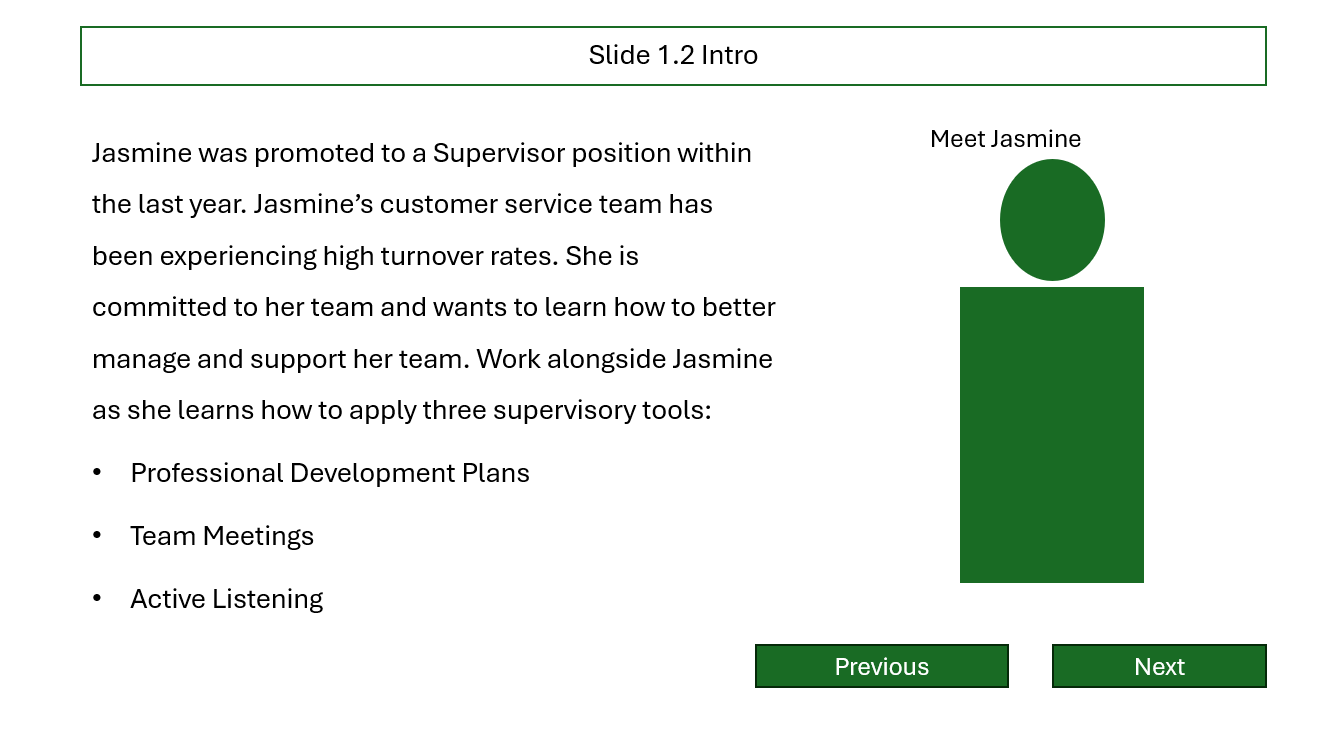Managing Challenges: Supervisory Skills
Supervisors play an important role in maintaining employee satisfaction and retention. Employee retention and satisfaction can impact a company’s efficiency and bottom line, as employee turnover can be costly and risk the loss of institutional knowledge.
This course is designed to help supervisors gain skills that will help them strengthen their teams and improve their ability to manage individuals. Supervisors will learn the following skills: active listening, writing SMART goals to support professional development, and how to run effective team meetings.
Project Details
Tools
Articulate Storyline
Miro
Envato Elements
PowerPoint
Inkscape
Skills
Storyboarding
Graphic Design
eLearning Development
Inital Design
The Challenge
Before starting the design process, I was tasked with considering and understanding the problem. Bikes R’ Us, a fictitious company, was experiencing high employee turnover in its customer service department. During exit interviews, employees cited lack of communication, lack of support from supervisors, and lack of career growth opportunities as reasons for leaving the company. Due to the increased employee turnover, hiring expenses had also increased.
The Solution
As part of a blended learning solution, designing an eLearning module that supports supervisors in developing skills and addresses the weaknesses reported by exiting employees seemed beneficial. Bikes R’ Us will create an eLearning module that will equip supervisors with skills that will improve communication and their ability to support their employees with professional growth and challenging situations.
Initially, I started by creating an action map, detailing the objective of the training and actions that would achieve this goal. I determined how the learner would be able to practice these actions and what information the learner needed to be successful. Then, I constructed an outline in Miro, breaking the course down into three sections correlating with the three skills I hoped learners would gain.
Storyboarding
An outline provided a starting point to create a written storyboard with development notes in PowerPoint. The storyboard detailed the real-life scenarios that would be utilized to describe relatable experiences that learners may encounter as well as demonstrate how to utilize supervisory skills in these situations. The written storyboard was also the first opportunity to make a rough sketch of the layout of each scene as well as how animation and user interaction would be incorporated. Before moving on to development, I created a visual style guide that would determine the visual look and feel of the course. The style guide was then utilized to make a visual prototype detailing the visual and written content for each scene.
Development
I developed the eLearning with Articulate Storyline. Applying Merril's Principles of Instruction, I wanted learners to be immersed in solving real-world problems and have the opportunity to work through situation-based problems alongside the supervisor in the training. Using visual role plays, learners were able to see situations they may have experienced in the workplace, drawing on prior knowledge and experience. I built tabbed interactions to allow learners to process information in a manageable and interactive manner. Visual demonstrations with click to reveal participation portrayed the parts of active listening. I utilized multiple choice questions to allow learners to define SMART goals; drag and drop to allow for completing an agenda; and branching scenarios to exercise decision making.








